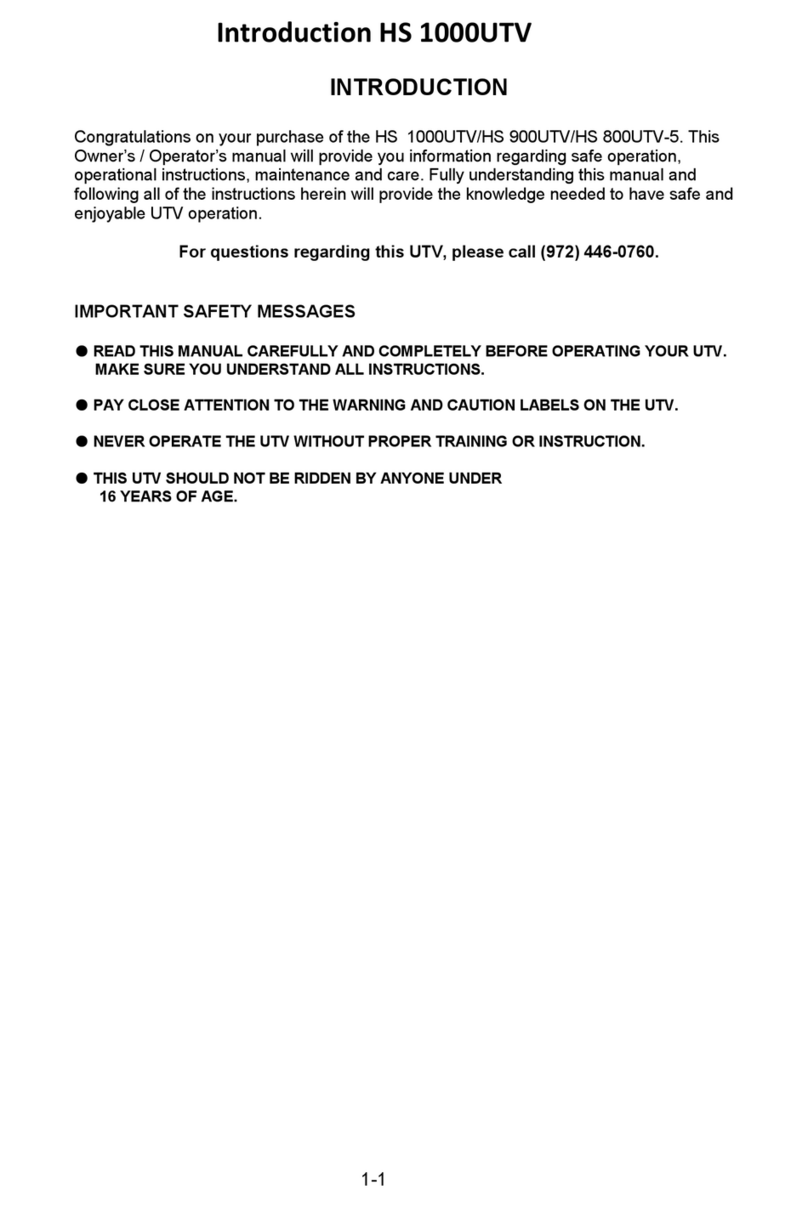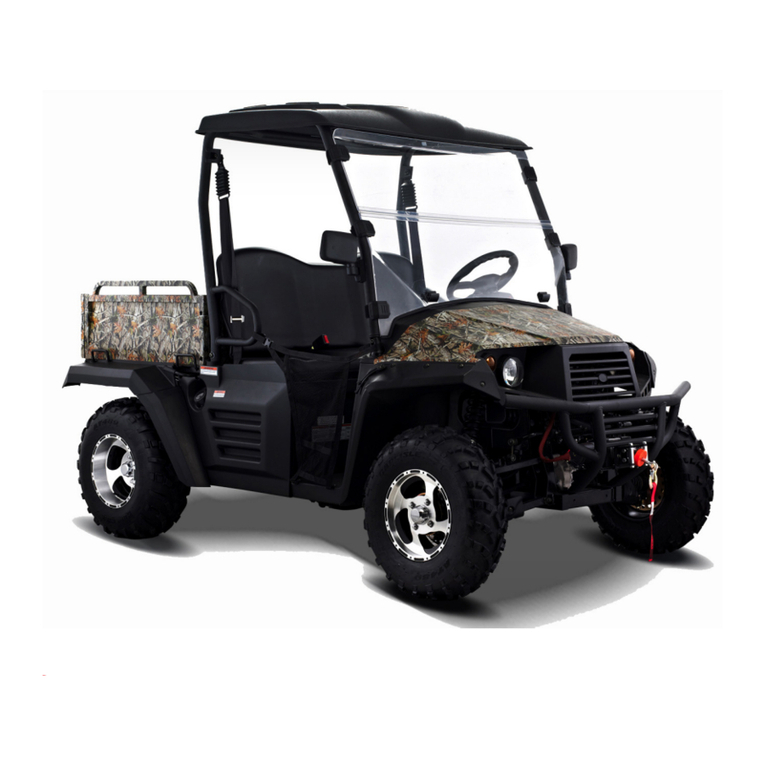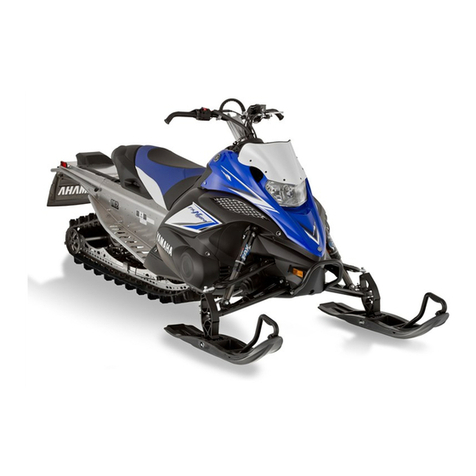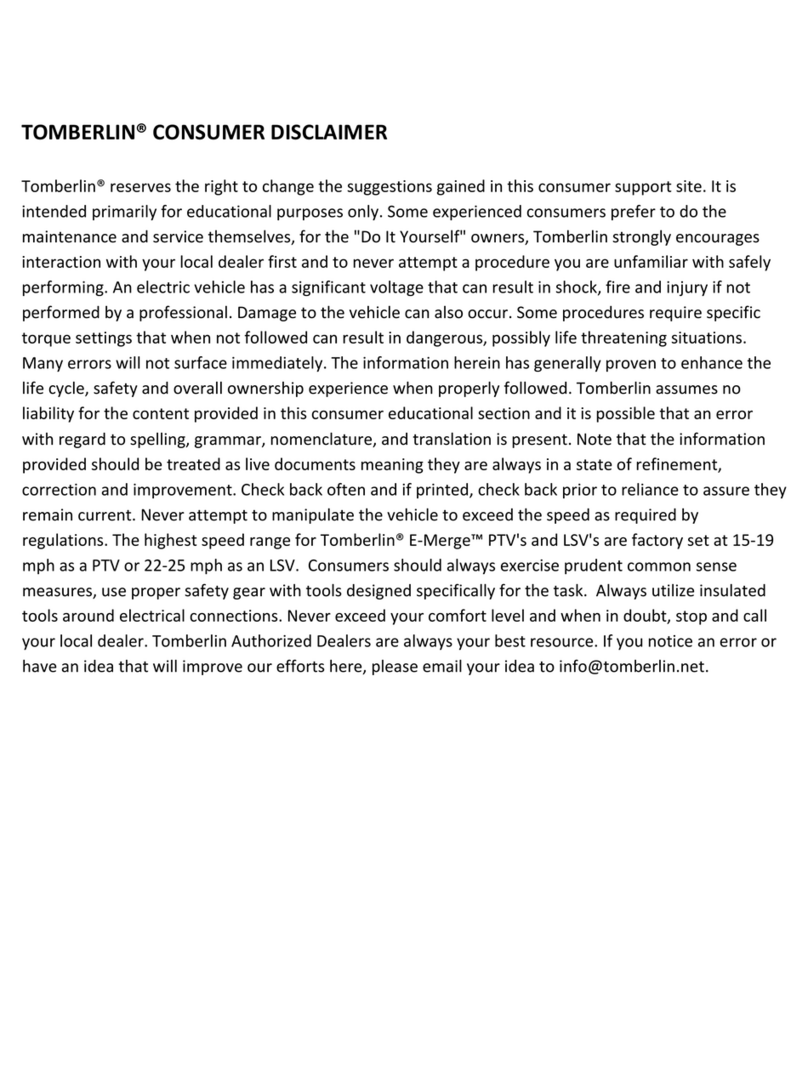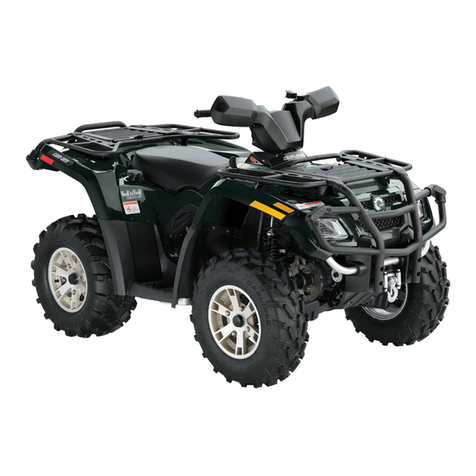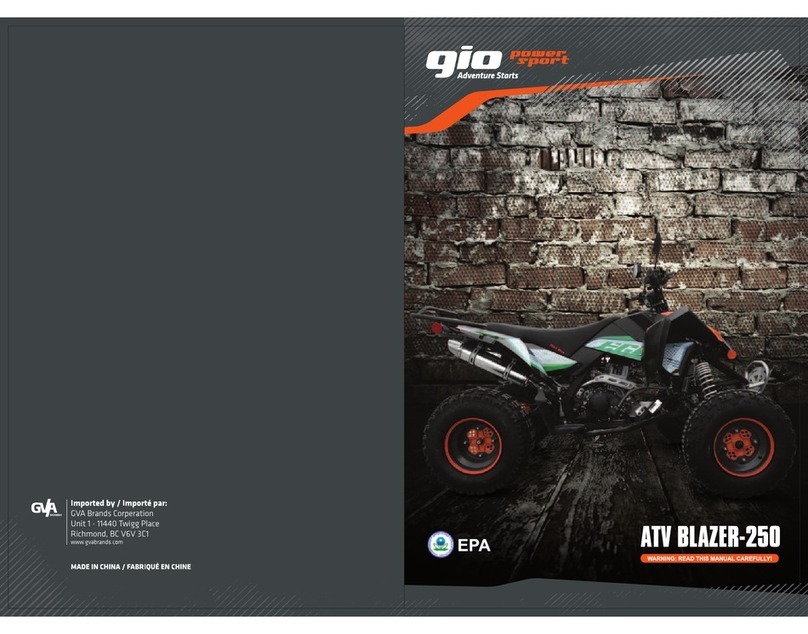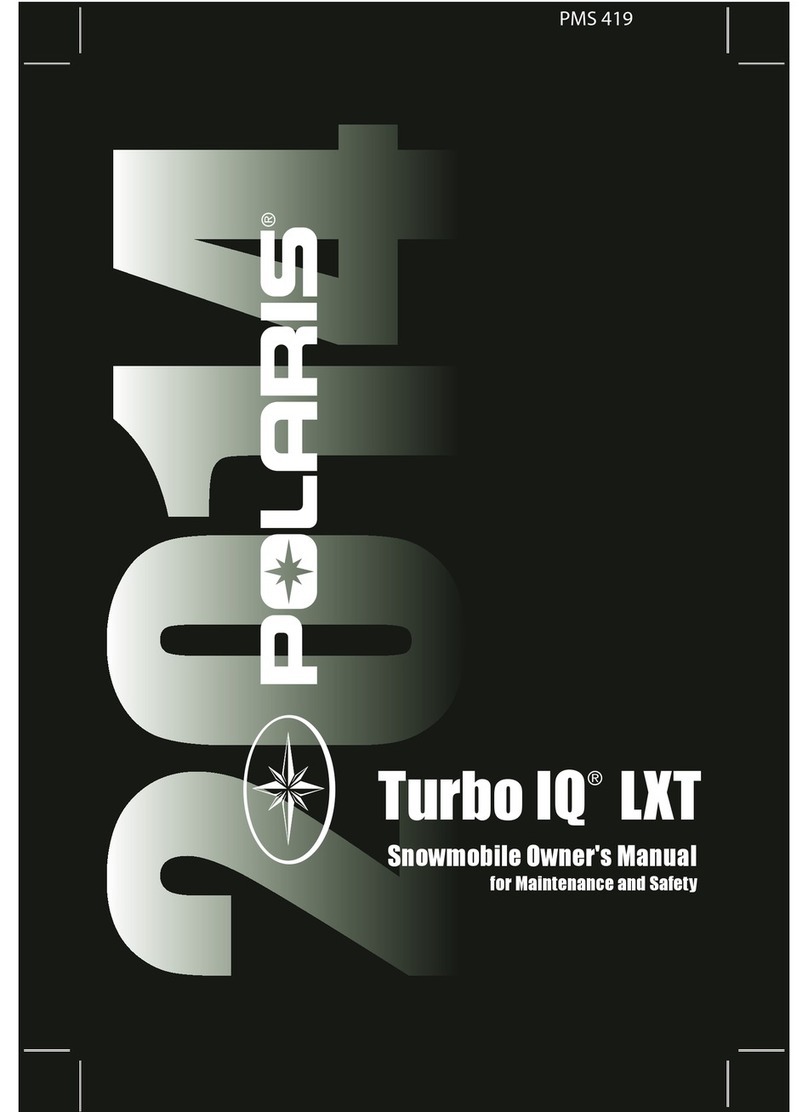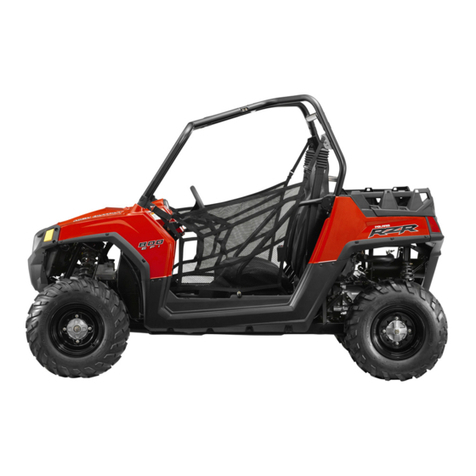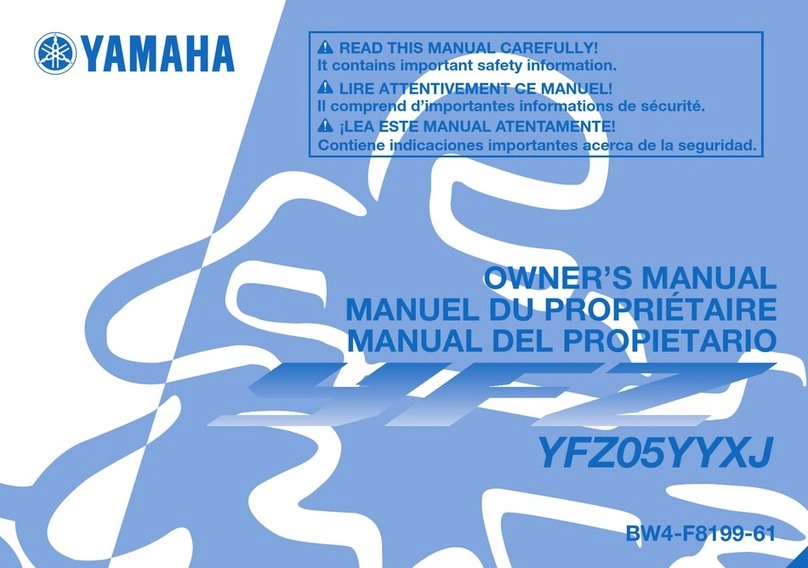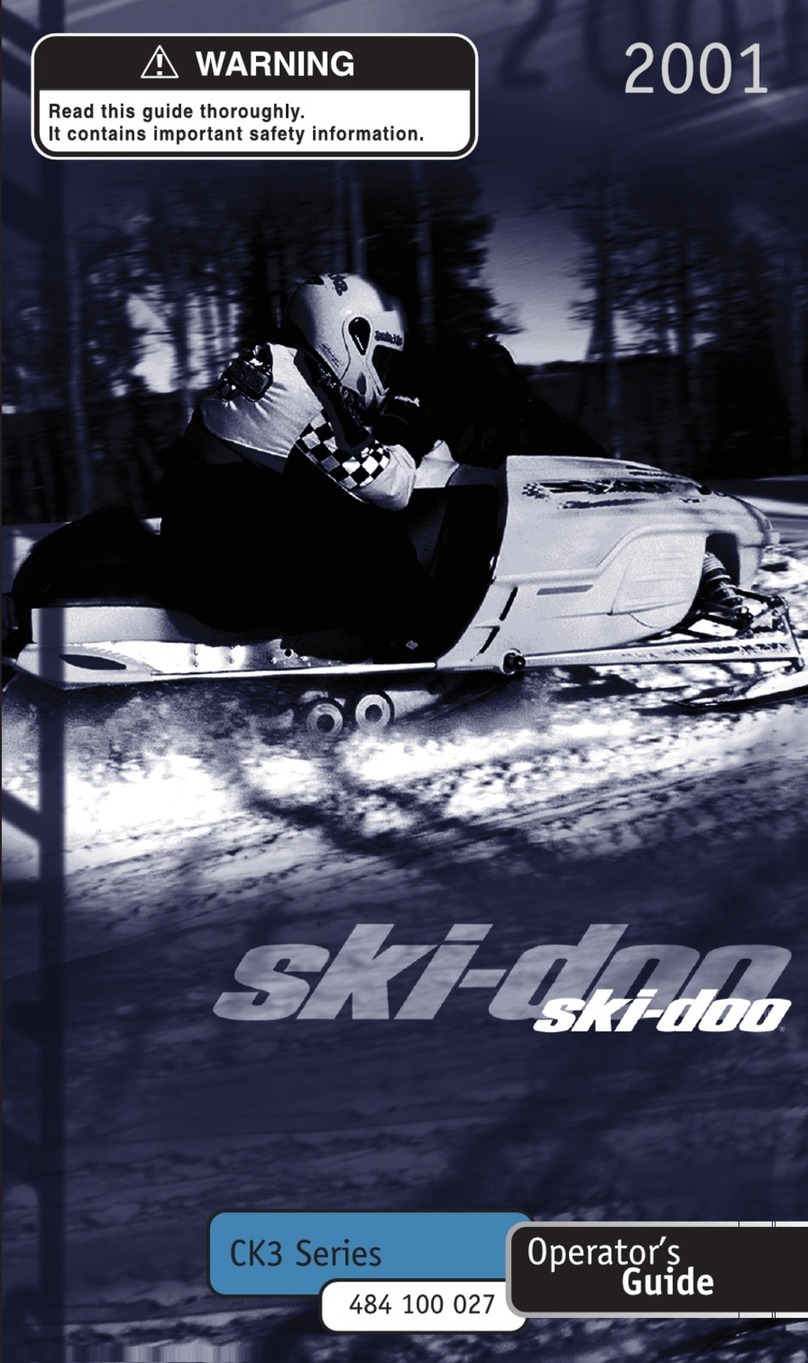Hisun STRIKE 1000 User manual

STRIKE 1000
OWNER’S MANUAL
TM
GRAB SOME SUN
Published by Chongqing
Huansong Industries
(Group) Co., Ltd and
Hisun Motors Corp USA.
Chongqing Huansong
Industries (Group) Co., Ltd
and Hisun Motors Corp USA
holds the copy right.
No publishing and reprinting
without permission.
READ THIS
MANUAL CAREFULLY
For questions regarding this
UTV, please contact HISUN at:
(972)446-0760
hisunmotors.com
Rev. 07231501
No one under the age of 16
should operate this vehicle.
Provincial / Municipal
governments have dierent
regulations pertaining to
owning and operating an
o-road vehicle; learn the
regulations in your area.

Introduction HS 1000 Strike
Intro-1
INTRODUCTION
Congratulations on your purchase of the HS 1000 UTV. This Owner’s / Operator’s manual will
provide you information regarding safe operation, operational instructions, maintenance and
care. Fully understanding and following all of the instructions in this manual will provide the
knowledge needed to have safe operation and longevity of the UTV.
For questions regarding this UTV, please call (972) 446-0760.
IMPORTANT SAFETY MESSAGES
●READ THIS MANUAL CAREFULLY AND COMPLETELY BEFORE OPERATING YOUR UTV.
MAKE SURE YOU UNDERSTAND ALL INSTRUCTIONS.
●PAY CLOSE ATTENTION TO THE WARNING AND CAUTION LABELS ON THE UTV.
●NEVER OPERATE THE UTV WITHOUT PROPER TRAINING OR INSTRUCTION.
●THIS UTV SHOULD NOT BE RIDDEN BY ANYONE UNDER 16 YEARS OF AGE.

Introduction HS 1000 Strike
Intro-2
IMPORTANT MANUAL INFORMATION
FAILURE TO FOLLOW THE WARNINGS CONTAINED IN THIS MANUAL CAN RESULT IN SERIOUS
INJURY OR DEATH.
Particularly important information is distinguished in this manual by the following
notations:
The Safety Alert Symbol means ATTENTION!
YOUR SAFETY IS INVOLVED!
Failure to follow WARNING instructions could result in severe injury or death to
the machine operator, bystander or a person inspecting or repairing the
machine.
A CAUTION indicates special precautions that must be taken to avoid damage
to the machine.
NOTE:
A NOTE provides key information to make procedures easier clearer.

Introduction HS 1000 Strike
Intro-3
IMPORTANT NOTICE
This UTV is designed and manufactured for OFF - ROAD use only. It is illegal and unsafe to operate this
UTV on any public street, road or highway.
This UTV complies with all applicable OFF - ROAD noise level and spark arrester laws and regulations in
effect at the time of manufacture.
Please check your local riding laws and regulations before operating this UTV.
When the temperature is below -4°F (-20°C), park the UTV in a place where the temperature is higher
than -4°F (-20°C). Operate the UTV after the UTV has warmed up. Please see page 7-3 on the warming
up process.
Follow the proper parking procedures when the temperature is higher than 100°F (38°C): turn off the
engine; make sure the radiator fan is on for 3 minutes before turning off the power switch.
Starting the UTV for the first time will take longer because the fuel will need reach the fuel injectors. To
start the UTV the first time, hold the ignition key on at 5-second intervals. Allow the starter to rest 15
seconds between each start attempt.

Introduction HS 1000 Strike
Intro-4
Table of Contents
Subject
Introduction
Warnings Cautions and Notes
Important Notice
Table of Contents
Safe Operation
Safety Instructions
Operation
Children Safety Instructions
Driving on a slope
Driving at high speed
Instructions for carrier
Parking
Transportation
Maintenance
Warning and Caution Labels
Identification Numbers
Specifications
Vehicle Limitations
Instrument Panel and Controls
Pre-Operation Check
Starting the Engine
Display Warning Lamps
Stopping the Engine
Operating the vehicle
Headlight switch
Hazard switch
Turn Signal switch
Brake Pedal
Gear Shift Lever
Parking Brake
Accelerator Pedal
Fuel Gauge
Coolant Temperature
Hour Meter, Speedometer
Winch Mount Plate
Maintenance
Service Intervals
Periodic Service
Hood, Seat, Cargo Bed
Front and Rear Shock
Adjustment
Jack positioning
Pre-Operation check
Fuel Tank
Engine Oil
Coolant Level
Brake Fluid Level
Page
Intro-1
Intro-2
Intro-3
Intro-4
1-1
1-1
1-2
1-2
1-3
1-3
1-3
1-4
1-4
1-4
1-5
1-8
2-1
3-1
4-1
5-1
6-1
6-2
6-3
7-1
7-2
7-2
7-2
7-3
7-3
7-4
7-4
7-5
7-5
7-5
8-1
9-1
9-1
10-1
10-1
10-3
10-5
10-5
10-6
10-6
10-6
10-6
Subject
Checking the Brake
Pedal
Checking the Parking
Brake
CV Boots
Tire Inflation
50 Hour
Wheel Lug Nut Torque
Cleaning the air filter
Evacuator valve
Battery condition
Battery Charging
Storage instructions
Adjusting Toe-In
Cleaning the Spark
arrester
200 hour check
Changing Engine oil
Replacing engine oil
filter
Checking the Brake
pedal stroke
Brake hoses and lines
Brake Light Switch
Radiator Hoses and
Clamps
Precautions at
overheating
Checking Intake air line
300 Hour check
Checking the tires
400 Hour check
500 Hour Check
1500 Hour check
Every 1 year check
Every 2 years check
Antifreeze
Every 4 years check
Replacing Mini Fuses
Replacing Light bulbs
EPS System
Storage
Removing the vehicle
from storage
Troubleshooting Engine
Diagnostic Trouble
Codes
Page
10-7
10-8
10-8
10-8
10-9
11-10
10-10
10-11
10-11
10-12
10-12
10-12
10-13
10-13
10-14
10-14
10-15
10-15
10-15
10-15
10-16
10-16
10-16
10-16
10-16
10-17
10-17
10-17
10-17
10-18
10-20
10-20
10-20
11-1
12-1
12-2
13-1
13-2

Introduction HS 1000 Strike
Intro-5
Battery Troubleshooting
Vehicle
Troubleshooting
Options
Emissions Warranty
13-3
13-4
14-1

Introduction HS 1000 Strike
Intro-6

SAFE OPERATION 1-1
SAFE OPERATION
All operators, including experienced UTV drivers or
passengers, should carefully read and fully
understand this Users Manual, and operate strictly
as the manual states in order to achieve the best
performance and avoid accidents. Everyone who
uses your UTV should be trained on how to
operate the UTV and be required to read this
manual before operation.
1. Safety Instructions:
1. Only start and operate the vehicle after you
have finished reading this manual.
2. Pay close attention to the warning and caution
labels on the UTV.
3. Understand completely and learn to use the
safety devices (roll-over protective structure,
seat belts), and never change the original
safety devices. If the safety devices are
damaged, consult your local dealer for
replacement.Always use seat belts.
①Roll-over protective structure;
②Seat belts;
4. Do not wear loose articles of clothing during
operation, as these can be drawn into moving
parts on the vehicle and could cause a severe
injury to occur.
You should always wear protective equipment,
such as helmet, boots, eye protection, ear
protection, and gloves etc.
5. Only a qualified driver with driving license
should operate this UTV. Never operate after
drinking alcohol, using drugs or controlled
substances, or while fatigued.
6. Always perform the pre-operation checks as
following:
1) Check seat belts for wear or damage, if
necessary, replace it.
2) Check brakes, throttle, brake pedal and
other mechanical parts for proper operation.
If you discover any irregularities, replace
related parts as necessary. Periodically
check the fittings and fasteners.
3) Check engine oil level and engine coolant
level.
4) Check that the UTV is equipped to handle
the surroundings.
5) Check and keep vehicle clean. Sludge,
grease and debris can cause a fire and
severe injury.
7. Passenger quantity and loading:
1) Only the driver and one passenger inside
cab. It is suggested that children under age
of 5 not be allowed as a passenger.
2) Single-row vehicle’s loading limit is 660lbs
(300KG). Reduce the loading weight
according to road conditions. Never exceed
the weight limits for operation.
8. Never allow unauthorized persons to repair
this UTV. This may affect vehicle performance
and cause injury.

SAFE OPERATION 1-2
2. Operation
1. Start the engine only in an open ventilated
area. Carbon monoxide is colorless, odorless
and is emitted from the engine and can cause
death in areas with poor ventilation .
2. Never start the vehicle or operate the gear
selector unless seated in the driver’s seat.
3. Never start the engine until the select lever is
placed in “N” position and the brake is in the
brake position.
4. The driver and passenger shall always wear
their seatbelt while the vehicle is being
operated.
5. Operators of the UTV should not wear
earphones.
6. Use the proper trailer hitch to haul cargo,
otherwise, serious injury or death can happen.
①Trailer Hitch
7. Do not accelerate quickly when starting the
engine, especially driving on rough terrain as
this can cause injury or death. Press the
accelerator pedal slowly.
8. Drive at slow speeds before braking.
9. When the differential is unlocked (DIFF.LOCK
is off) the front/rear wheels can turn at
different speeds to assist in the stability of the
vehicle.
10. Never drive over terrain such as a ditch, a hole,
dams, excessive mud, or the vehicle can get
stuck because of the vehicles weight.
11. Always pay close attention to your
surroundings, and check for streets, trail
intersections or other obstacles.
12. Always use signals in advance of turns.
13. Do not allow entrance or exit of the vehicle
while it is moving.
14. Keep the floorboard free of debris that can
obstruct the ability to use the brake pedal.
15. Position your hands on the steering wheel.
Always keep your hands and feet inside
passenger area of the vehicle. Never try to
stand while operating the vehicle.
16. Do not tow passengers, or attempt to jump the
vehicle.
3. Children safety instructions
Always watch children when they are around the
vehicle. Children like to imitate adults and this
could lead to an accident.
Do not leave children alone beside the vehicle.
Keep children from the operating area of the
vehicle.
Turn off the engine and remove the key when
children are in the operating area.
Never carry children in the cargo area. This is very
dangerous to children. Children under age of 5
should not be allowed in this vehicle.
Never allow children to touch or climb on the
vehicle, even if they are under adult supervision.
Always check for people or obstacles behind the
vehicle before shifting the vehicle into reverse.
Avoid a collision with an obstacle or person.
Park the vehicle on a firm, flat area. If parking on a
slope, you should use hand lever parking brake
then remove the key.

SAFE OPERATION 1-3
4. Driving on a slope
Be cautious when riding on a slope, as this is the
main reason for loss of control, and overturn,
leading to severe injury or even death.
1. Drive in a straight line on a slope at a
low-speed.
2. Reduce weight when riding on a slope or
rough terrain.
3. Avoid the sudden application of the brakes
when you go uphill or downhill. Be more
careful when vehicle turns on a slope.
4. If you start to lose momentum or need to park
when climbing, use the hand lever brake to
come to a stop. Release the brake and begin
to coast down the hill.
5. If do not believe you can operate the UTV
safely in reverse do not attempt to ascend the
slope any further.
6. Riding in mud, a ditch, and on slopes will
increase the risk of an overturn. Be more
cautious when operating in 4WD, vehicle
traction will increase and it is easy to misjudge
for vehicle’s ability to climb a grade.
7. Drive gradually and slowly when climbing.
Avoid suddenly changes of vehicle speed or
direction.
5. Driving in harsh conditions
1. Vehicle can be operated during the day or
under good light conditions.
2. Under all conditions, both operator and
passengers should wear helmet and
protective equipment.
3. The Driver should slow down according to
road conditions, terrain, visibility conditions.
4. Be cautious when driving over a ditch, stone
roads or hidden obstacles.
Avoid operating in any unknown depth of water.
(water depth should not exceed axle height).
Driving at high speed
1. Check the condition of the front and rear
wheels.
2. Pay attention to the difference of braking
performances between two and four-wheel
drive. Slow down when turning. Turning at
high speeds, may result in overturn or even
death.
3. Turn on your headlights at high speeds.
4. Drive only when the vehicle speed can be
controlled.
5. Do not use DIFF.LOCK when driving at high
speeds. This may cause loss of control of the
vehicle.
6. When driving at high speeds, sudden turning
of the steering wheel will reduce vehicle
stability. Never sharply turn the steering wheel
at high speeds.
7. Instructions for carrier
1) Never carry a passenger in the cargo area.
2) Evenly distribute the cargo to maintain proper
stability. Avoid overloading the carrier. Cargo
should be securely attached.
3) Reduce loaded weight when driving on poor
road conditions or on steep inclines.
4) Only the driver should be in the seat when
operating the hydraulic dump mechanism (if
applicable). Once lowered, lock the cargo bed
in place before operating the vehicle. Don’t put
your hands or your body under the cargo bed
when the carrier is lifted (if applicable). Avoid
driving before securing and locking the cargo
bed.

SAFE OPERATION 1-4
8. Parking
1. Set the gear shift to the “N” position and pull
the braking brake to the top position to park
the vehicle.
2. Avoid stopping the vehicle on a slope. If
stopping on a slope make sure the vehicle is
stationary before exiting.
①Parking brake lever.
②Pull to “PARK”
9. Transportation
1. Avoid dragging the vehicle behind another
vehicle. Use a trailer or truck to transport the
vehicle.
2. When loading or unloading, pay attention to
your surroundings and others in the area.
9. Maintenance
Stop the vehicle and park it on level ground. Pull
the parking brake and remove all cargo. Place the
shift lever in the “N” position, stop the engine and
remove the key.
1. When working next to the engine, exhaust,or
radiator, work only after it has cooled down.
2. Wait for the engine to stop running and cool
down before checking the coolant level.
Otherwise, you could be burned by hot fluid or
steam.
3. No smoking when adding electrolyte or
refueling. The fuel tank and battery should be
kept away from sparks. The battery produces
hydrogen and oxygen during charging and this
could accelerate the risk of explosion.
4. Read and follow the instructions before
replacing the battery.
5. During maintenance, first aid kits and fire
extinguishers should be placed at your
fingertips.
6. During maintenance, you should disconnect
the battery cables.
①Battery
7. Do not open the radiator cap before coolant
has cooled down. When the coolant is cold,
open slowly and let the coolant pressure
reduce, and then open radiator cap. Check for
the coolant level in the coolant reservoir. If
necessary, add coolant.
8. Tires should be mounted on rims with special
equipment, only by professionals.
9. Keep the specified tire pressure to ensure
driving safety.
10. Elevate the vehicle and place a suitable stand
under the frame when removing the wheels.
Be sure to re-tighten the wheel nuts to the
specified torque.

SAFE OPERATION 1-5
Warning and caution labels
(1)
(3)
(5)
(6)
(2)
(4)
(7)

SAFE OPERATION 1-6
(8)
(9)
(11)
(14)
(10)
(12)
(13)
(15)

SAFE OPERATION 1-7
(16)
(17)

SAFE OPERATION 1-8
SERVICING OF VEHICLE
Your dealer is interested in your new vehicle and
has the desire to help you get the most value from
it. After reading this manual thoroughly, you will
find you can do some of the regular maintenance
by yourself.
However, when in need of parts or major service,
be sure to see your dealer.
For service, contact the dealership from which you
purchased your vehicle or your local dealer.
When in need of parts, be prepared to give your
dealer both the vehicle and engine serial numbers.
Locate the serial numbers now and record them in
the space provided.
Type
Serial No.
Vehicle
Engine
Product Identification
Number
Date of Purchase
Name of Dealer
①Vehicle serial number.
①Engine serial number

SPECIFICATIONS 2-1
SPECIFICATIONS
SPECIFICATION TABLE
Model
Specification
Engine
Make
Type
2 cylinders, 4-cycle, gasoline, OHV, liquid cool
Displacement(s)
cc
976CC
Horsepower
Kw (HP)
48.85(65.51)
Rated revolution
rpm
7500
Low idling revolution
rpm
1350 to 1500
Low idling revolution
L(U.S.gal)
≥28 (7.39)
Transmission
CVT
Wheels, Drive system
4, Rear 2WD or 4WD
Differential lock
Electric control: switch
Gear selection
Hi-Lo range forward, Neutral, Reverse
Brakes
Front/Rear
Hydraulic disk brakes
Parking brake
Rear wheel, hand lever
Steering
Electronic power
Suspension
Front
Independent, Dual A-arm type
Rear
Independent, Dual A-arm type
Dimensions
Length
mm(in.)
2880 (113.4)
Wide
mm (in.)
1760(69.3)
Height
mm (in.)
1900(74.8)
Front tread centers
mm (in.)
1385 (54.5)
Rear tread centers
mm (in.)
1350 (53.1)
Wheelbase
mm (in.)
2160(85)
Ground
Clearance
front axle
mm (in.)
350(13.77)
rear axle
330(13)
Turning diameter
m (ft)
7.4(24.277)
Towing Capacity
kg (lbs.)
590(1300)
Payload capacity (Cargo Bed)
kg (lbs.)
159(350)
Gross Vehicle Weight
kg (lbs.)
348(768)

SPECIFICATIONS 2-2
Model
Specifications
Cargo bed
Width
mm (in.)
1160 (45.67)
Length
mm (in.)
690(27.16)
Depth
mm (in.)
230(9.05)
Volume
m3 (cu.ft.)
0.24(8.47)
Bed height
(unloaded)
mm (in.)
927(36.49)
Cargo bed capacity
kg (lbs.)
159(350)
Sound level, operator ear
db (A)
85
Tire
Front
27×9-14 6PR
27×9-14 6PR
Rear
27×11-14 6PR
27×11-14 6PR
Body color
Various
NOTE:
The values in “Ground clearance” and “Weight” are those of the machine equipped with the tires in the
table above.
The company reserves the right to change the specifications without notice.
TRAVELING SPEEDS
Range gear shift lever
km/h (mph)
Low
79 (49)
High
115 (72)
Reverse
40 (25)

VEHICLE LIMITATIONS 3-1
VEHICLE LIMITATIONS
The Vehicle has been thoroughly tested for proper performance with implements sold or approved. Use
with implements which are not sold or approved and which exceed the maximum specifications listed
below, or which are otherwise unfit for use, vehicle may result in malfunction or failures of the vehicle
damage to other property and injury to the operator or others, [Any malfunctions or failures of the vehicle
resulting from use with improper implements are not covered by the warranty]
Max. Cargo loading weight
Rear trailer hitch
Cargo Bed Capacity=159Kg (350 lb)
Max Trailer rolling weight
590 kg (1300 lbs.)
Max. tongue weight
53 kg (127 lbs.)
1. Above mentioned specifications are based on level ground condition.

INSTRUMENT PANELAND CONTROLS 4-1
INSTRUMENT PANEL AND CONTROLS
LOCATION OF PARTS
①Roll-over protective structure.
②Front hood
③Hazard/Turn signal light (if equipped)
④Headlights
⑤Winch mount plate

INSTRUMENT PANELAND CONTROLS 4-2
ILLUSTRATED CONTENTS
①Steering wheel
②Brake pedal
③Accelerator Pedal
④Cup holder
⑤Gear indicator
⑥Tachometer
⑦Speedometer
⑧DC socket
⑨Gear shift lever (Range)
⑩Parking brake lever
Table of contents
Other Hisun Offroad Vehicle manuals

Hisun
Hisun HS750ATV User manual

Hisun
Hisun 700UTV User manual
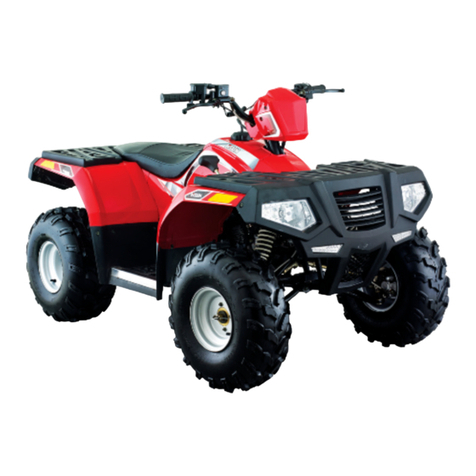
Hisun
Hisun AXIS 110 User manual

Hisun
Hisun HS 400 User manual

Hisun
Hisun HS500ATV User manual

Hisun
Hisun HS 200UTV-2 User manual

Hisun
Hisun HS 500 User manual

Hisun
Hisun HS 500UTV-5/HS User manual
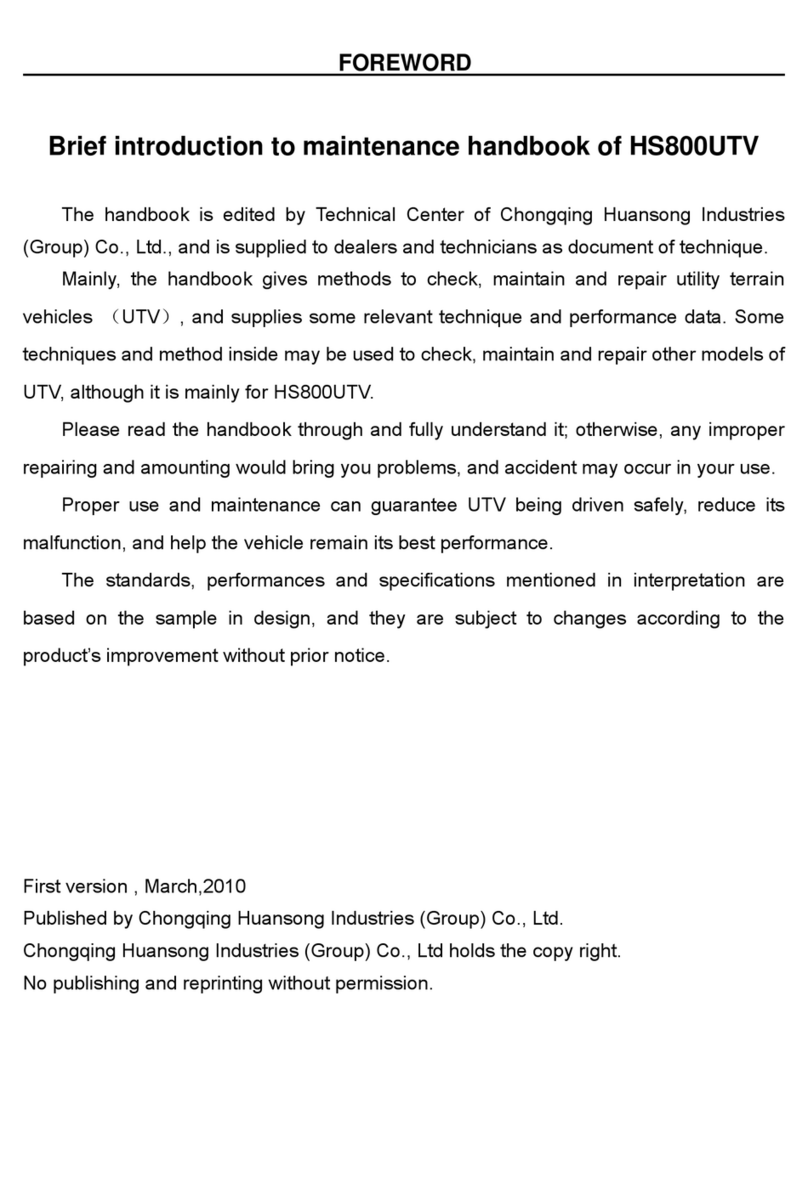
Hisun
Hisun HS800UTV User manual
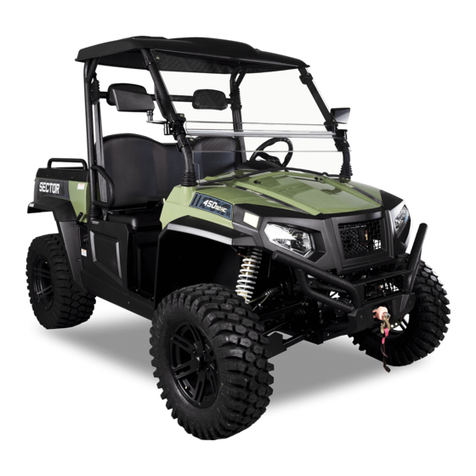
Hisun
Hisun HS 400-4 Reference manual

